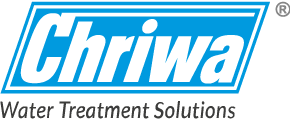Ion exchange
Ion exchange is a process in which water flows through a container filled with exchange resins. Synthetic organic ion exchangers are mainly polymerisation resins based on styrene or acrylate.
Ion exchange is a reversible process. The uptake of ions from the water is only possible until the functional groups are fully loaded, which must then be restored to the receptive state by regeneration.
Different processes for high flexibility and efficiency
Chriwa offers various processes for this purpose, depending on your raw water:
Direct current process
Countercurrent process
Countercurrent counterpressure
Floating bed process
Multistep filter
Mixed bed filter (working and fine purification mixed bed)
The following exchange resins can be used for water treatment:
Cation exchange resins:
Weak acid cation exchangers
Weak acid cation exchangers are mostly polyacrylic resins, generally with carboxyl groups as functional groups. They have a largely selective effect on cations that can be assigned to the anion of carbonic acid, i.e. are strongly dissociated in the water. The main field of application is therefore also decarbonisation, i.e. the removal of hydrogen carbonates from water with the release of carbon dioxide and retention of the hardness ions calcium and magnesium at the exchanger. These exchangers can also be used for the neutralisation of regeneration wastewater.
Strong acid cation exchangers
Strong acid cation exchangers are polystyrene resins with sulfonic acid groups as functional groups. In the Na form, they are used to soften water. The hardness ions are absorbed by the exchanger and exchanged for sodium ions. In the H form, strongly acidic cation exchangers are used for the decationisation of water. They absorb the cations from the electrolyte and release hydrogen ions, so that mineral acids (HCl, H2SO4 and partly HNO3) are freely present in the effluent.
Anion exchange resins:
Weakly basic anion exchangers
Weakly basic anion exchangers are polyacrylamide or polystyrene resins with a macroporous backbone and tertiary amino groups as functional groups. As a rule, ion exchange does not really take place on weakly basic exchangers, but they accumulate free acids, primarily the strong mineral acids, with protinisation of the functional groups. For this reason, it is common to connect a weakly basic anion exchanger behind a strongly acidic cation exchanger in order to be able to remove the free mineral acids from the water.
Strong base anion exchangers
Strong base anion exchangers are also polystyrene or polyacrylamide resins with quaternary ammonium groups as functional groups. They can absorb the anions of both weak and strong acids, even from salts, in exchange for hydroxide ions. In addition, there are macroporous resins in the Cl form here, which are also used as adsorbers upstream of the cation stage to remove orgnic substances from water (so-called scavengers).

